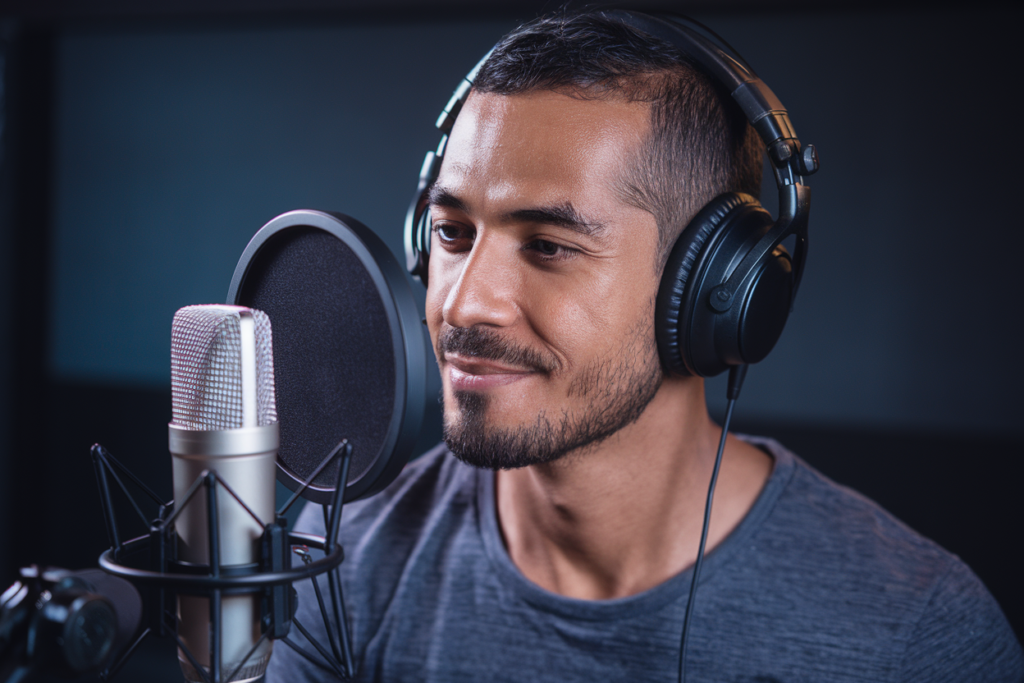Key Takeaways
- Dominance of Egyptian Arabic: Egyptian Arabic is the leading dialect in Arab cinema due to its unique phonetic traits and rich cultural history, making it more relatable for audiences.
- Distinct Characteristics: The dialect features a melodic pronunciation, a mix of classical and vernacular vocabulary, and prevalent slang, enhancing its expressiveness in film dialogues.
- Cultural Impact: Egyptian Arabic has evolved over centuries, influenced by various cultures; its prominence in early 20th-century cinema helped solidify its status across the Arab world.
- Comparative Dialects: Understanding Levantine and Gulf Arabic reveals diverse storytelling techniques; each dialect brings distinct emotional tones that influence audience engagement differently.
- Role in Storytelling: Dialects significantly shape narratives and character development. Egyptian Arabic often enhances emotional expression, while other dialects offer varied interpretations based on cultural contexts.
- Authenticity in Representation: The use of different dialects enriches cinematic authenticity and reinforces cultural identity within storytelling frameworks across Arab films.
Ever wondered why Egyptian Arabic dominates the silver screen? It’s not just about the captivating stories or stunning visuals. Understanding the nuances of Egyptian Arabic compared to other dialects can unlock a whole new appreciation for films from the region.
Overview of Egyptian Arabic
Egyptian Arabic stands out as a widely recognized dialect in the Arab world, particularly in cinema. Its distinct characteristics and rich history contribute to its prominence in films.
Characteristics of Egyptian Arabic
Egyptian Arabic features unique phonetic traits that set it apart from other dialects. The pronunciation often emphasizes certain sounds, making it more melodic and expressive. Common vocabulary includes words derived from both classical Arabic and local vernacular, enriching its character. Additionally, the use of slang is prevalent, providing a relatable touch for audiences. These elements create a distinctive voice that resonates with viewers.
Historical Context
The roots of Egyptian Arabic trace back to ancient Egypt but evolved significantly over time due to various influences, including Ottoman Turkish and French colonialism. The rise of Egyptian cinema in the early 20th century helped solidify its status as the dominant dialect in film. The popularity of Egyptian actors and actresses further popularized this form of speech across the Arab world, ensuring that their performances reached diverse audiences who appreciate this engaging voiceover style. Understanding this context enhances your appreciation for regional cinema’s depth and cultural significance.
Comparison with Other Dialects
Egyptian Arabic stands out in films, yet other dialects offer unique traits worth exploring. Understanding these differences enhances your appreciation of regional cinema.
Levantine Dialect
Levantine Arabic encompasses varieties spoken in countries like Lebanon, Syria, Jordan, and Palestine. This dialect showcases a playful tone and rhythmic speech patterns that create an engaging atmosphere on screen. Films featuring Levantine characters often highlight melodrama or romance, appealing to audiences through emotional narratives. The diversity within the Levantine dialect adds depth; different regions have distinct pronunciations and vocabulary that enrich character development and storytelling.
Gulf Arabic
Gulf Arabic is prevalent in films from the Arabian Peninsula, including Saudi Arabia, Kuwait, Qatar, Bahrain, Oman, and the UAE. It features a more formal tone compared to Egyptian Arabic but maintains its own charm through cultural references and expressions specific to the Gulf region. Films using Gulf Arabic often focus on themes such as tradition and modernity clash or socio-economic issues affecting local communities. The presence of voice actors proficient in Gulf dialects can significantly impact how stories resonate with viewers familiar with those cultural nuances.
Exploring these dialects not only broadens your understanding of Arab cinema but also shows how voice talent adapts performances to fit each unique linguistic landscape.
Representation in Films
Egyptian Arabic holds a vital role in film representation, shaping narratives and character development. Its widespread use across the Arab world allows it to bridge cultural gaps, making stories accessible to diverse audiences. The unique phonetic qualities of Egyptian Arabic enhance emotional expression, enriching dialogue and performance.
Role of Dialects in Storytelling
Dialects like Egyptian Arabic significantly influence storytelling techniques. Each dialect brings distinct rhythms and tones that affect how characters communicate. For instance, voice talent often adapts their delivery based on regional nuances. In romantic films featuring Levantine dialects, you might notice playful language that heightens emotional engagement. Gulf Arabic tends to convey more serious themes through its formal structure, allowing for deeper discussions about tradition versus modernity.
Impact on Audience Perception
The choice of dialect directly impacts audience perception and connection with the film’s narrative. Egyptian Arabic’s melodic nature often evokes familiarity among viewers, leading to stronger emotional reactions. Conversely, when exploring films in other dialects such as Levantine or Gulf Arabic, audiences experience varied interpretations influenced by cultural context. This diversity enriches your understanding of Arab cinema while showcasing the adaptability of voice actors as they embody different linguistic landscapes effectively.
In essence, the representation of various dialects not only enhances cinematic authenticity but also reinforces cultural identity within storytelling frameworks.
Analysis of Popular Egyptian Films
Egyptian films have captured audiences for decades, showcasing the richness of Egyptian Arabic through storytelling and performance. The unique qualities of this dialect contribute significantly to the emotional depth and cultural context within these cinematic experiences.
Iconic Films Featuring Egyptian Arabic
Numerous iconic films exemplify the strength of Egyptian Arabic in conveying complex narratives. Movies like “The Yacoubian Building” or “Cairo 678” utilize Egyptian Arabic not just as a language but as a vital tool for character development. Their dialogue resonates with authenticity, drawing viewers into the cultural nuances that define their characters’ motivations and struggles. The performances by voice actors in these films enhance this connection, adding layers to the storytelling that might be lost in translation.
Reception of Non-Egyptian Dialects in Egyptian Cinema
Non-Egyptian dialects often appear in various roles within Egyptian cinema, yet their reception tends to vary. For instance, Levantine accents frequently pop up in romantic comedies, where playful banter captures audience attention. In contrast, Gulf Arabic may present more formal themes that can sometimes create distance from local viewers. While some appreciate this diversity, others feel a stronger connection to stories told purely in Egyptian Arabic due to its melodic nature and familiarity.
In essence, understanding how different dialects impact film representation enriches your appreciation for Arab cinema as a whole. Each dialect offers distinct flavors; however, it’s clear that Egyptian Arabic remains pivotal in shaping narratives that resonate deeply with both regional and global audiences.
Conclusion
Egyptian Arabic stands out as a powerful force in the realm of film. Its melodic qualities and rich historical context create an emotional depth that resonates with viewers. By understanding its nuances compared to other dialects, you can truly appreciate the artistry behind Arab cinema.
Exploring different dialects reveals the diversity within storytelling, each adding layers to narratives and character development. Whether it’s the playful tones of Levantine or the formal structure of Gulf Arabic, each contributes uniquely to cinematic experiences.
As you delve into Egyptian films, remember how these dialects shape connections with characters and themes. Embracing this linguistic richness enhances your viewing experience and deepens your appreciation for the cultural significance embedded in every performance.
Frequently Asked Questions
What is Egyptian Arabic’s significance in cinema?
Egyptian Arabic plays a crucial role in films due to its wide usage and cultural resonance. Recognized for its distinct phonetic traits and blend of classical and local vocabulary, it enhances storytelling by making dialogue more melodic and expressive. This dialect has become integral to regional cinema, especially since the rise of Egyptian films in the early 20th century.
How does Egyptian Arabic compare to other Arabic dialects?
Each Arabic dialect offers unique characteristics. For example, Levantine dialects have playful tones suitable for emotional narratives, while Gulf Arabic often conveys serious themes with a formal tone. Understanding these differences can enhance appreciation for Arab cinema as each dialect enriches storytelling through distinct rhythms and expressions.
Why is understanding dialects important for film appreciation?
Grasping the nuances of different dialects allows viewers to better connect with narratives and characters. Each dialect’s unique qualities affect emotional expression and audience perception. By understanding how language influences storytelling techniques, viewers can gain deeper insights into character development and cultural contexts within Arab films.
Can you give examples of popular Egyptian films that use Egyptian Arabic effectively?
Yes! Films like “The Yacoubian Building” and “Cairo 678” showcase the power of Egyptian Arabic in character development. The authentic dialogue resonates with audiences, adding depth to performances that might be lost without this linguistic context. These films highlight how language shapes emotional engagement with viewers.
How do non-Egyptian accents fare in Egyptian cinema?
Non-Egyptian accents are received differently depending on the context. Levantine accents are often embraced in romantic comedies due to their relatable nature, while Gulf Arabic may create distance among local viewers because of its formal themes. The choice of accent impacts audience connection with the story being told.







